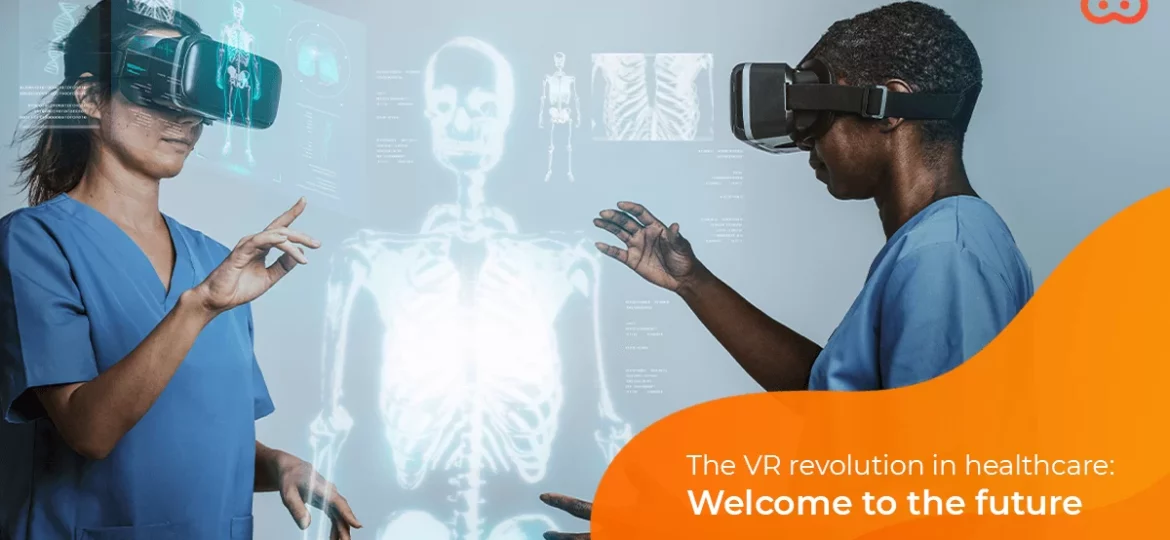
Virtual Reality (VR) has taken the world by storm with its potential to unlock a new level of creativity and opportunity pertaining to a wide range of industries. VR is among the most disruptive technologies on the planet, but few industries have demonstrated the tech’s potential, quite like healthcare. In the last few years, countless enterprises have begun experimenting with VR for a multitude of purposes to maximize its full utilization. From providing solutions to chronic pain management to enhancing medical training without live patients or cadavers, VR tools are being used for a variety of purposes today. The technology can also provide robotic surgery opportunities, educate patients about disease prevention, and even provide psychological counseling. Let us look at the evolution of VR in healthcare and the opportunities in the field that can be explored in the near future.
The potential of Virtual Reality in Healthcare
According to Goldman Sachs Global Investment Research, healthcare will be among the top 3 industries adopting VR technologies by 2025. 82% of healthcare professionals agree that VR revolutionizes how we access and learn the latest information. More than 62% of patients welcome VR healthcare solutions as an alternative to traditional solutions.
The most recent report by Global Newswire suggests the healthcare VR market will reach $40.98 billion by 2026 (approximately), up from $2.70 billion in 2020.
Many factors are driving the growing adoption rates of VR within the healthcare sector. Virtual reality’s popularity in healthcare has risen dramatically since the pandemic, as has any disruptive technology trend. Patients and healthcare providers are unable to meet and interact in person, which has resulted in an increasing need for alternative types of care, such as telemedicine and biometric data tracking. VR provides an excellent opportunity to ensure patients can get direct, visual, and engaging guidance from the doctors in their hour of need. VR has also contributed to:
- Enhancing lives: VR tools not only help make it easier for patients to connect with their doctors, but they also improve the way people recover from illnesses and manage chronic pain.
- Improving the process of acquiring new skills: Virtual reality can help users develop new skills by enabling them to perform various tasks efficiently without using cadavers or wasting resources.
- Assisting specialists in their collaboration: Even in a world of remote work, VR technology allows experts to collaborate more on intricate procedures or strategizing on public health campaigns. VR is an advancement above traditional video conferencing that enables healthcare professionals to share and engage with data, visual information, and patient insights in real-time while communicating in a virtual environment.
The next massive thing: Metaverse in healthcare
In 2022, the Metaverse will be a significant technological gamechanger in healthcare, similar to the introduction of telemedicine and mobile device integration before it.
The Metaverse, a combination of virtual reality (VR) and augmented reality (AR) technology, operates in virtual spaces, and its potential is staggering. From surgical precision to therapeutic applications, social-distancing accommodations, and much more, all signs point to the Metaverse as a disruptive innovation in healthcare. The benefits of Metaverse in healthcare and patient care can be as follows:
VR’s growing influence in medical training: Metaverse’s user-immersion features make it an excellent tool for training healthcare professionals. Here are some directions Metaverse is heading in.
- Tactile, haptic controls augment simulation training, such as trainees obtaining a close-up view of a surgeon’s surgery.
- VR may transport a learner inside the human body and provide a 360° perspective of a patient’s disease through interactive training modules.
Digital therapeutic applications: This form of therapy has begun to see rapid adoption, where VR and AR tech in the Metaverse enables cognitive therapy, support groups, psychiatric evaluations, rehabilitation, and even physical therapy – with haptic sensors.
Opportunities for VR in healthcare
In recent years, Virtual Reality (VR) has expanded its applications and accessibility to the healthcare industry. VR applications, however, are primarily applicable in the research realm in the current scenario. There is limited information about what healthcare professionals would need in order to integrate VR applications into their daily work routines independently. AR-VR providers like Proven Reality can fully capitalize on the upcoming opportunities, as VR is the future, and healthcare professionals are ready to adapt VR tools to enhance their efficiency at work, as shown in a Frontiers.Org survey.
Conclusion
The integration of VR into the healthcare routine is still a work in progress. Despite this, given the speed with which technology is evolving, VR in healthcare as an everyday occurrence does not seem too far-fetched. Virtual Reality technology will progressively be applied in the coming years to improve the accuracy and efficiency of current procedures and to improve the capabilities of human beings, both as caregivers and patients. With the widespread development and adoption of VR in the medical industry, it would not be an exaggeration to say that the future of this technology looks more and more promising.
If you want to join the VR revolution, write to us at [email protected].

